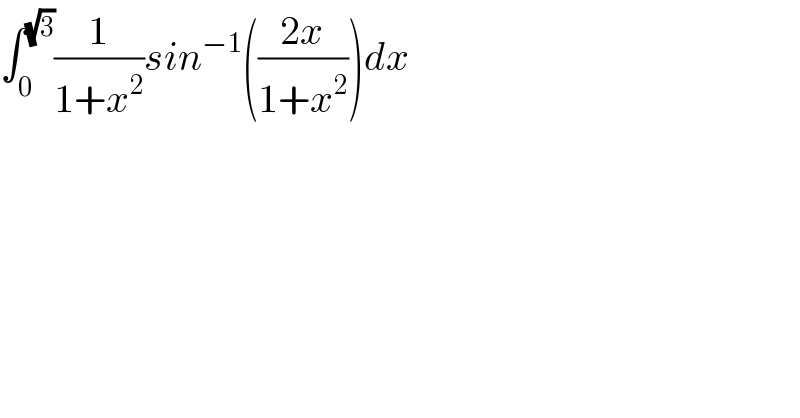
Question and Answers Forum
Question Number 90796 by M±th+et+s last updated on 26/Apr/20

Commented by mathmax by abdo last updated on 26/Apr/20
![I =∫_0 ^(√3) (1/(1+x^2 )) arcsin(((2x)/(1+x^2 )))dx cyangement x=tanθ give I =∫_0 ^(π/3) (1/(1+tan^2 θ)) arcsin(sin(2θ))(1+tan^2 θ)dθ =∫_0 ^(π/3) 2θdθ =[θ^2 ]_0 ^(π/3) =(π^2 /9)](Q90891.png)
Commented by M±th+et+s last updated on 27/Apr/20

Commented by mathmax by abdo last updated on 28/Apr/20

Answered by TANMAY PANACEA. last updated on 26/Apr/20
![∫(1/(1+x^2 ))sin^(−1) (((2x)/(1+x^2 )))dx x=tana ∫(1/(sec^2 a))×sin^(−1) (sin2a)sec^2 a da a^2 so answer [∣tan^(−1) x∣_0 ^(√3) ]^2 →((π/3))^2 =(π^2 /9)](Q90797.png)
Commented by M±th+et+s last updated on 26/Apr/20

Answered by M±th+et+s last updated on 28/Apr/20
![I=∫_0 ^(π/3) (1/(1+tan^2 θ))sin^(−1) (((2tanθ)/(1+tan^2 (x))))d(tanθ) =∫_0 ^(π/3) cos^2 (θ) sin^(−1) (sin2θ)(1/(cos^2 (θ)))dθ ∫_0 ^(π/3) sin^(−1) (2θ)dθ the last tricky! sin^(−1) sinθ≠θ,θ>[(π/2)]! (1) this is because sin^(−1) (θ) to be a function it must defined as a mapping only to sub−region of R. specifically: sin^(−1) :[−1,1]→[((−π)/2),(π/2)] :x→θ=sin^(−1) (x) therefore.following gives a one to one mapping: sin^(−1) sin:[((−π)/2),(π/2)]→[((−π)/2),(π/2)] in our case the argument is 2θ so our range get coparessed by a factor of two so we get ollowing one to many mapping: sin^(−1) sin(2×_):[((−π)/4),(π/4)]→[((−π)/2),(π/2)] with a littile thought we can extand past (π/4) to (π/2) and obtain following plot of sin^(−1) sin2θ with θ∈[0,(π/2)] which is a one to many mapping: so the integral is just the area under the curve from 0 to π/3 breaking this up: ⇒for θ∈[0,(π/4)],the area of the triangle is (π^2 /(16)). ⇒for θ∈[(π/4),(π/3)],the area trapeziod is 5π^2 /144 summing these two,gives ((7π^2 )/(72)) (2)](Q91118.png)
